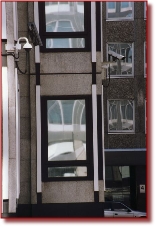 |
||
 |
||
![]()
![]()
![]()
![]()
![]()
![]()
![]()
![]()
![]()
![]()
![]()
![]()
![]()
![]()
![]()
![]()
![]()
![]()
![]()
![]()
![]()
![]()
![]()
![]()
![]()
![]()
![]()
![]()
IMPORTANT: No material may be reproduced, copied or redistributed from this site, without the express written consent of doktorjon.co.uk
All the detailed information on this site is provided in good faith; and as such, Doktor Jon does not accept responsibility for any consequential loss, injury or disadvantage resulting from any individual or organisation acting on the details contained herein.
© doktorjon.com 2004 - 2010
The Site Management role may come in to play if there is a need to observe whether a particular person is leaving the building, for example, monitoring the safety of Security Guards as they carry the cash boxes to a waiting CIT (Cash in Transit) security van.
In the event of intruders gaining access, or a concerted attack, the ‘passive’ Evidential Recording function will become paramount.
In this context, Doktor Jon would normally recommend a somewhat 'alternative' approach, which is effectively a ‘double deception’.
The main camera unit located in the service corridor near to the door would be .... a dummy camera. This model, whilst having all the outward appearance of a normal working unit, would provide the ‘focus’ for attention as a deterrent.
To fulfil the remaining functions, a very high resolution colour camera will be installed covertly, so that as well as providing an unrestricted view of the door and service corridor, it would also provide coverage of the dummy camera. If anyone tries to tamper with ‘the camera’ it will be caught by the covert unit.
Depending on the number of employees and overall footfall, the camera may only need to be constantly displayed in the control room at key times during the day, for example, ninety minutes either side of the centre opening or closing, and when high risk personnel such as Cash in Transit (CIT) guards or jewellery suppliers are accessing the corridor.
If a PIR or similar movement sensor is located to monitor the area in the cameras field of view, outside of 'peak' constant observation periods, the image can then be automatically switched for display when someone moves in front of the camera
As you would of course expect, clear identification level Evidential Quality Recording would be maintained at all times, although with more advanced digital record systems, it would be useful to reduce the number of recorded images per second to an absolute minimum, when there is nobody present. That would help conserve disc space, whilst still providing a continous evidential audit.

- The Service Access Door -
20% Deterrence 30% Incident Monitoring
20% Site Management 30% Evidential Recording
The Service Door will be used by all personnel and contractors to gain access to the restricted 'staff only' areas of the centre.
As such, the Deterrence aspect does not really apply quite as strongly to members of staff (who are already aware that there's a comprehensive CCTV security system in place), other than as a reminder that they are being recorded every time they pass along the Service corridor.
![]()
![]()
![]()
![]()
![]()
![]()






